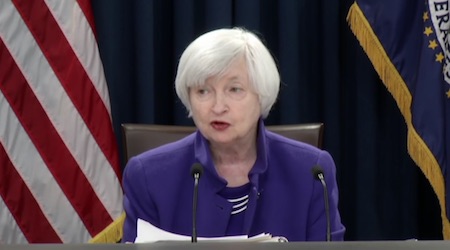As expected, the Fed raised interest rates at its December meeting. This was a mistake.
Economic growth has been stagnant since the financial crisis. In particular, slow productivity growth has adversely affected aggregate economic growth. Slow economic growth has led to lower wage growth, which, in turn, has led to diminished consumer demand and lower price inflation. From low inflation, the Fed has kept interest rates low for a long period, thereby reinforcing economic stagnation. Yet, despite historically slow economic growth, the Fed has decided to increase interest rates so as to constrain asset bubbles in equities and real estate.
It should be evident that there is a profound disconnect between Fed policies and the market. For example, the bond market is pricing interest rates very low because investors see slow economic growth and sub-par investment opportunities. Nevertheless, the Fed is proceeding with increasing interest rates in the near term despite a clear pattern of stagnation.
The consequences of this disconnect between the Fed and the bond market is very likely a self-inflicted recession in which short-term interest rates are driven much higher than long-term rates. The disconnect between the market and the Fed is illustrated by the probable inversion of the yield curve in which short-term rates rise to a point higher than long-term rates. In the past, yield curve inversion has predicted recessions because with short-term rates relatively high, lending is suffocated and, therefore, asset price bubbles are pierced without continued access to capital.
Why are rates increasing when the market sees a slowdown of growth? First, there is a link between productivity growth and aggregate economic growth. In recent years, economic growth has been stagnant because of very slow (or negative) productivity growth. Productivity growth has been extremely low because businesses have substantially reduced investment in new technologies since the financial crisis. One explanation for the phenomenon of investment reduction has been the reluctance of banks to lend to risky technology companies or for companies to invest in long-term R&D. Another explanation suggests a disincentive for companies to invest in R&D because of the increased costs and diminished rewards associated with reduced patent rights.
Investment in technology research is a key driver of productivity growth. This is where we find a link between the patent system and business investment in new technologies. The patent system has supported these investments by supplying a property right to an invention. However, in recent years, a cartel of large technology companies has influenced patent policy, which has been changed to require patents to be enforced in the courts and in tribunals in the Patent and Trademark Office (PTO), virtually eliminating a voluntary licensing market. The high costs of patent enforcement have driven most companies without large resources to withdraw from the market, enabling the tech cartel to flourish, but dramatically diminishing aggregate investment in R&D.
As a consequence, large technology incumbents have enjoyed the opportunity to efficiently infringe others’ patents by raising barriers to enforcement and by effectively reducing remedies. Most large technology companies now simply ignore patents, refuse to deal with market entrants and simply wait to be sued for infringement. When they are enforced, patents are then re-examined in the PTO, with high kill rates because of a lack of due process and asymmetric burdens on patent holders. Only large companies can play this game since the costs run into the millions to enforce or defend patents, driving out small companies in droves.
These behaviors have had a profound adverse effect on productivity growth, with the lowest productivity growth rate in generations. Since the technology incumbents attack patents in the courts and PTO, shifting the burden and high costs to patent holders, patent valuations have declined. With lower valuations, the incentives to invest in R&D have been reduced.
The Fed has been oblivious to the mechanisms of market economics and technology investment driven by the degradation of patent rights in recent years. While the Fed focuses exclusively on inflation and the labor market, they have ignored factors driving technology investment and the disintegration of the patent system that has underscored the declining business investment trend. With a degraded patent system, investors have shifted to other asset classes or markets rather than investing in technology.
The other side of the coin is that a cartel of giant tech companies has benefited from high barriers for technology development. These companies have enjoyed Brobdingnagian profits and market capitalization, in part because of diminished competition and in part because of a torrent of investor activity in the absence of alternative investment options.
Some of the solutions to the productivity growth crisis include strengthening the patent system so as to induce technology investment. For example, the PTO re-exam practice can be refined so as to supply some semblance of due process. The courts can also respond by enhancing the patent right so as to encourage investment and protect the endangered entrepreneur.
In addition, the government can enforce the antitrust laws, which will have the effect of increasing competition for technology entrants, providing incentives for business investment and increasing valuations for R&D in the market.
A great effort has been expended to refine tax policy with the belief that changes will supply incentives to invest in research that will ultimately benefit productivity growth. At the end of the day, however, the economy cannot function optimally without a strong patent system. Once policy makers make changes that benefit patent holders and supply incentives to investors risking investment capital, there should be strong productivity growth and healthy overall economic growth.
Until that time, however, the Fed is likely to artificially induce a recession in the short run because of a lack of knowledge of the functioning of the patent system and the adverse effects of the behavior of the tech cartel.

![[IPWatchdog Logo]](https://ipwatchdog.com/wp-content/themes/IPWatchdog%20-%202023/assets/images/temp/logo-small@2x.png)


![[Advertisement]](https://ipwatchdog.com/wp-content/uploads/2024/05/Quartz-IP-May-9-2024-sidebar-700x500-1.jpg)
![[Advertisement]](https://ipwatchdog.com/wp-content/uploads/2024/04/Patent-Litigation-Masters-2024-sidebar-last-chance-700x500-1.jpg)

![[Advertisement]](https://ipwatchdog.com/wp-content/uploads/2021/12/WEBINAR-336-x-280-px.png)
![[Advertisement]](https://ipwatchdog.com/wp-content/uploads/2021/12/2021-Patent-Practice-on-Demand-recorded-Feb-2021-336-x-280.jpg)
![[Advertisement]](https://ipwatchdog.com/wp-content/uploads/2021/12/Ad-4-The-Invent-Patent-System™.png)






Join the Discussion
No comments yet.